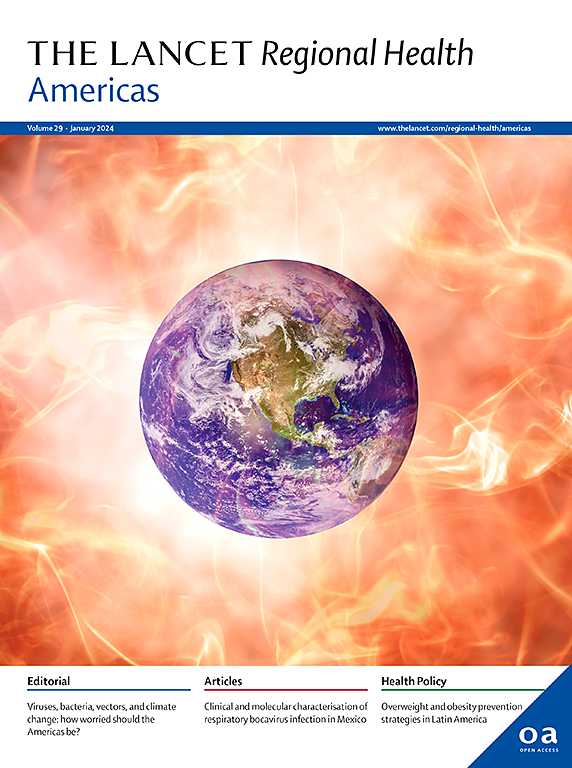Active West Nile virus transmission in Brazil: an epidemiological study
IF 7
Q1 HEALTH CARE SCIENCES & SERVICES
引用次数: 0
Abstract
Background
West Nile virus (WNV) is a mosquito-borne flavivirus that can cause neurological and fatal disease in animals and humans. Since its introduction into the USA in 1999, WNV has become the leading arbovirus in North America. In contrast, no major WNV outbreak has been reported in South America. Our study investigated active WNV circulation in Brazil.
Methods
We examined WNV epidemiological, molecular, genomic, and serological data from Brazil from January 2014 to December 2024. We also conducted WNV testing in 561 patients with febrile illness, neuroinvasive disease, or death between January 2019 and January 2024 in Ceará State, Brazil. Next, we conducted time series, mapping, ecological niche modeling, age-sex distribution, phylogenetic analyses, and statistical hypothesis tests.
Findings
Between January 2014 and December 2024, 110 West Nile cases were reported from 13 of 27 Brazilian states. In addition, our retrospective study in Ceará State revealed 12.1% (68 of 561 patients) were WNV cases, peaking in 2023, when 42.6% (29 of 68) of cases occurred. Among WNV cases, 7 (10.3%) had detected WNV RNA in serum, cerebrospinal fluid, or both, whereas 62 (89.7%) were IgM-positive, with 29 presenting with neurological complications, 35 with febrile illness, and four fatalities. WNV cases were reported in all months, with the highest numbers between May and August. Most cases were female (female-to-male ratio, 1.1:1), and the median age of patients was 40 years (interquartile range, 20–57). Our phylogenetic analysis showed that WNV lineage 1a circulated in Ceará State and caused a fatal horse case. Our ecological niche models identified several areas, mainly situated in the Northeast region, linked to a potentially higher risk of human exposure to local WNV circulation.
Interpretation
These findings comprehensively described consistent WNV circulation in Brazil and may contribute to informing public health policy, focusing on the strategies to determine the WNV burden in South America.
Funding
Burroughs Wellcome Fund, Wellcome Trust, National Institutes of Health, São Paulo Research Foundation, Brazilian Ministry of Science, and Brazilian National Council for Scientific and Technological Development.
西尼罗河病毒在巴西的活跃传播:一项流行病学研究
西尼罗河病毒(WNV)是一种蚊媒黄病毒,可引起动物和人类的神经系统和致命疾病。自1999年传入美国以来,西尼罗河病毒已成为北美主要的虫媒病毒。相比之下,南美洲未报告发生重大西尼罗河病毒疫情。我们的研究调查了巴西活跃的西尼罗河病毒传播。方法分析2014年1月至2024年12月巴西西尼罗河病毒流行病学、分子、基因组和血清学资料。我们还对2019年1月至2024年1月期间巴西塞埃尔州的561例发热性疾病、神经侵袭性疾病或死亡患者进行了西尼罗河病毒检测。接下来,我们进行了时间序列、制图、生态位建模、年龄-性别分布、系统发育分析和统计假设检验。2014年1月至2024年12月期间,巴西27个州中的13个州报告了110例西尼罗河病例。此外,我们在加州的回顾性研究显示,12.1%(561例患者中有68例)为西尼罗河病毒病例,2023年达到高峰,当时发生42.6%(68例患者中有29例)的病例。在西尼罗河病毒病例中,7例(10.3%)在血清、脑脊液或两者中检测到西尼罗河病毒RNA, 62例(89.7%)为igm阳性,其中29例出现神经系统并发症,35例出现发热性疾病,4例死亡。所有月份都报告了西尼罗河病毒病例,5月至8月期间的数字最高。大多数病例为女性(男女比例为1.1:1),患者年龄中位数为40岁(四分位数范围为20-57岁)。我们的系统发育分析显示,西尼罗河病毒1a谱系在加利福尼亚传播,并导致了一个致命的马病例。我们的生态位模型确定了几个地区,主要位于东北地区,与人类暴露于当地西尼罗河病毒传播的潜在较高风险有关。这些发现全面描述了西尼罗河病毒在巴西的持续传播,并可能有助于为公共卫生政策提供信息,重点是确定南美西尼罗河病毒负担的策略。资助:巴勒斯的惠康基金、惠康信托、美国国立卫生研究院、圣保罗研究基金会、巴西科技部和巴西国家科学技术发展委员会。
本文章由计算机程序翻译,如有差异,请以英文原文为准。
求助全文
约1分钟内获得全文
求助全文
来源期刊

Lancet Regional Health-Americas
Multiple-
CiteScore
8.00
自引率
0.00%
发文量
0
期刊介绍:
The Lancet Regional Health – Americas, an open-access journal, contributes to The Lancet's global initiative by focusing on health-care quality and access in the Americas. It aims to advance clinical practice and health policy in the region, promoting better health outcomes. The journal publishes high-quality original research advocating change or shedding light on clinical practice and health policy. It welcomes submissions on various regional health topics, including infectious diseases, non-communicable diseases, child and adolescent health, maternal and reproductive health, emergency care, health policy, and health equity.
 求助内容:
求助内容: 应助结果提醒方式:
应助结果提醒方式:


